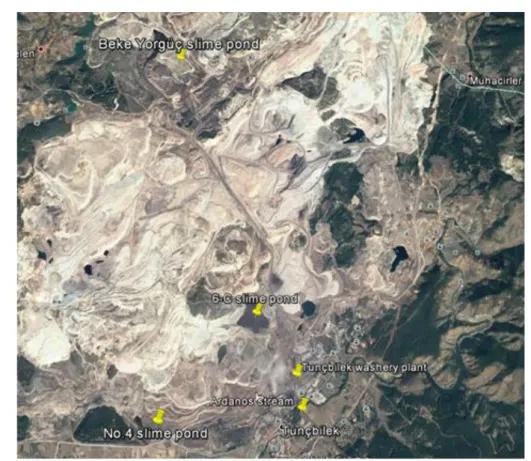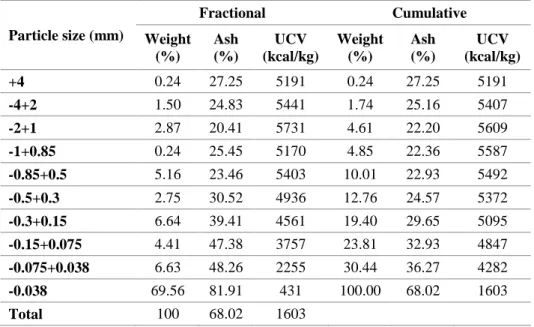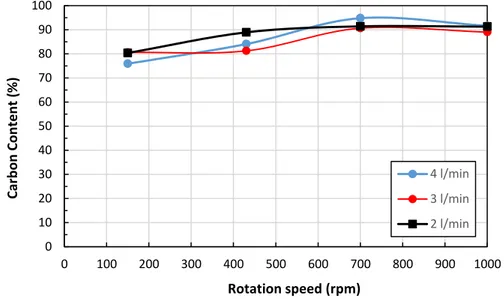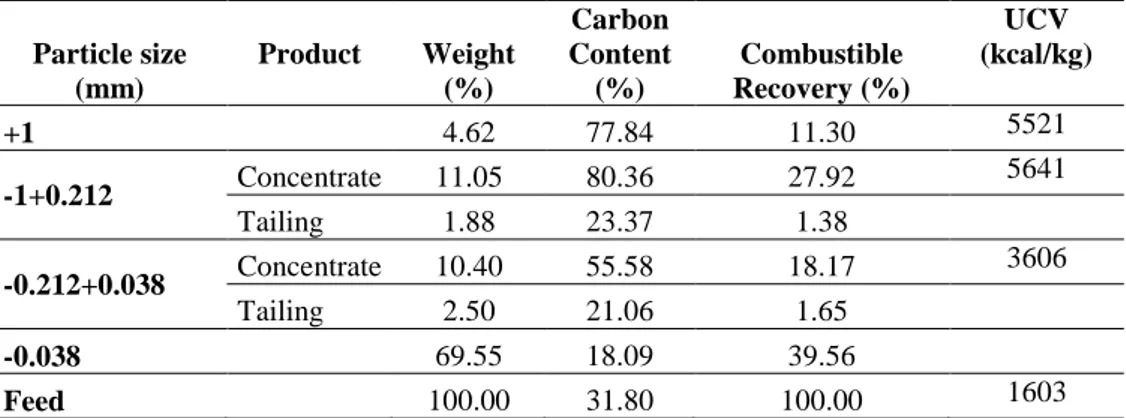RESEARCH ARTICLE
215
RECOVERY OF COAL SLIME BY USING THE KNELSON CONCENTRATOR Ali UÇAR1,*, Oktay ŞAHBAZ2, Nezahat EDİZ3, Sevgi KARACA4, İ.Göktay EDİZ5
1 Kütahya Dumlupınar University, Faculty of Engineering, Department of Mining Engineering, Kütahya, ali.ucar@dpu.edu.tr,
ORCID:0000-0002-5220-8829
2 Kütahya Dumlupınar University, Faculty of Engineering, Department of Mining Engineering, Kütahya,
oktay.sahbaz@dpu.edu.tr, ORCID: 0000-0003-0945-9048
3 Kütahya Dumlupınar University, Faculty of Engineering, Department of Mining Engineering, Kütahya,
nezahat.ediz@dpu.edu.tr, ORCID: 0000-0001-9619-7589
4 Kütahya Dumlupınar University, Faculty of Engineering, Department of Mining Engineering, Kütahya,
sevgi.karaca@dpu.edu.tr, ORCID: 0000-0001-7478-2437
5 Kütahya Dumlupınar University, Faculty of Engineering, Department of Mining Engineering, Kütahya,
goktay.ediz@dpu.edu.tr, ORCID: 0000-0003-0874-1113
Received Date:05.10.2020 Accepted Date: 15.12.2020
ABSTRACT
The coal slimes are formed during the gravity processes applied at the coal preparation plant (Coal Washery). After the washing process of coal, large amounts of fine coals with a high calorific value is being discharged to the abandoned open cast spaces causing economic losses and significant environmental problems. A re-processing of these coal slimes by using the newcomer separation devices, such as Knelson concentrator, is a necessity due to the filling up of ponds, requirements of new legislation, and so on. In this study, the recovery of fine coal slimes of Tuncbilek Washery in Kutahya-Turkey was carried out by using the Knelson Concentrator (KC). Besides, the effect of particles sizes on the recoverability of fine coals was also investigated to reach optimum recovery. According to the particle size analysis made for this purpose, the maximum particle size of the samples was found as 4 mm while the ratio of material below 0.038 mm was found as 69.66%. From the chemical analysis made (ash, calorific value), it was also found that the ash content and the upper calorific value of the waste material 68% and 1603 kcal/kg, respectively. After the coal processing studies carried out using the KC for two different particle size groups, it was realized that the recovery rate was highly reduced at carbon content which is the indicator of the valuable substance while it was slightly decreased at lower particle sizes. When all the coal processing results were considered, it could be concluded that clean coal with 70% carbon content and an upper calorific of 4807,9 kcal/kg could be obtained through a combustible recovery of 57.4%.
Keywords: Coal Recovery, Knelson Concentrator, Slime Pond, Western Lignite Corporation 1. INTRODUCTION
Coal, an organic sedimentary rock, contains minerals and combustible organic substances in the maceral structure. Coal is heterogeneous at certain levels. At its simplest level, it is a mixture of organic and inorganic phases. However, the mineral material of the coal is composed of inorganic
Uçar et all., Journal of Scientific Reports-A, Number 45, 215-224, December 2020.
216
constituents of the plant, other organic substances and the inorganic constituents which have different structures and liberation characters carried to coal bed [1].
Coal preparation and enrichment is a process in which the value of raw coal is increased by reducing the content of impurities such as inorganic matter. The quality of the operation depends on many parameters, and particle size is one of the most important parameters. The finer the particle size is, the harder the separation will be. Therefore, it very hard to separate coal slimes from the gangue. Increased fine size coals called as slimes caused due to the fragile nature of the coals and the increased mechanized production methods cannot be enriched using the existing methods. These fine coals not only cause economic loss but also cause environmental problems. Such causes necessitate the evaluation of the coal in the fine fractions. Besides, slimes, are problematic for coal washeries. Coal slimes processing plants have higher water content and are generally stored in a waste dam near the coal mine. These slimes are problematic in terms of processing due to the fine size, oxidization, and so on [2]. Many researchers have investigated to find the most appropriate method to separate coal slimes from the inorganic materials due to the environmental and economical concerns. Types of equipment that make the separation between organic and inorganic components of coal (+0.1 mm) for the enrichment purposes such as heavy media, jig, shaking table, spirals, cyclone, etc. are effectively used for mining industry efficiently with low cost. However, the recovery decreases for fine size by using these types of equipment, and if the size is less than 0.1 mm, the enrichment is rather difficult and costly [3, 4]. Advanced gravimetric enrichment, based on centrifugal forces, and flotation methods have become more effective in the separation of such fine size coal [5, 6, 7, 8]. However, in the flotation process, environmental problems arise together with the costs of the reagents, and the oxidization of coal [4, 9, 10, 11]. Therefore, centrifugal force-based gravity concentrator seems higher potential to separate coal slimes from gangue minerals.
Centrifugal separators using the gravity-based separation mechanism can be divided into three basic types: vertical axis machines (Knelson, Falcon etc.), centrifugal jigs (Altar jig, Kelsey jig) and horizontal axis machines (Multi-Gravity separator). By using high gravitational force of these devices, efficient and effective separation of ultra-fine free particles is made possible [6, 10, 11, 12].
Based on the aforementioned trends, it is clear that there is a need for a highly effective physical coal cleaning technology to recover fine coals present in modern coal preparation plants. One of these separators is the Knelson Concentrator (KC) with a vertical axis conical bowl type that performs the concentration process using the fluidized bed mechanism. The different series of KCs are used for different application purposes, such as base metals and coal industries all over the world. KC has the advantages of simple construction, small installation space, high capacity, recovery for large particle sizes, and most importantly the benefits of having very large enrichment rates up to 1000: 1 in a single step. The separation principle of KC is based on the difference between centrifugal forces applied to heavy and light particles and separation bed fluidization [4, 6, 9, 10, 12, 13, 14].
The movement of a particle in a centrifugal fluid bed depends on the number of parameters, such as the geometry of the conical reservoir, the physical properties of the particles, and the operational conditions of the concentrator. The efficiency of the KC also depends on some basic parameters such as the size of the feed particles, the feed type, the feed particle class, the feed rate, the centrifugal force density, the concentration cycle, the bed fluidizing water flow rate and pressure. Minor changes
Uçar et all., Journal of Scientific Reports-A, Number 45, 215-224, December 2020.
217
in these parameters can cause significant variations in the effectiveness of the separation process [13, 14].
Previous studies on the enrichment of coal in different sizes and properties have been carried out by some researchers. In these studies, the effect of fluidizing water rate, centrifugal force and feed rate on the separation was investigated.
Sabah and Koltka (2014) obtained a clean coal containing 30.51% ash with a amount of 81.18% for the particle size of -0.5+0.038 mm having 42.6% ash content from Aegean Lignite Corporation (ALC) waste pond [15].
Honaker et al. (1996) obtained a clean coal with 8% ash and 85% combustible recovery by using the KC. In this study feed size is -0.6 + 0.210 mm and an ash content of the feed is 21% [6]. Honaker and Das (2004) also obtained a clean coal with 8% ash content and 90% combustible recovery from the feed of 22% ash content with a size range of -0.150 + 0.044 mm by using a pilot scale KC [16]. According to a study carried out by Oney and Tanriverdi (2016) on the enrichment of Amasra coals containing 34.30% ash with a size of -1 + 0.15 mm, a clean coal with 16.28% ash content was obtained with a combustible recovery of 67.82% [14].
In another work carried out by Uslu et al. (2012), oxidized coal with a high-sulphur content was classified by the size ranges of -0.106, -0.300 + 0.106 and -0.500 + 0.300 mm and then enriched with KC. 99.13% combustible recovery and 60.94% carbon content were achieved in the range of -0.500 + 0.300 mm [4].
Tunçbilek coal processing plant of Western Lignite Corporation (WLC) was taken into operation in 1952 while Ömerler coal washery of the same corporation has been in service since 1993 in Tunçbilek, Kütahya (Turkey). Coal processing is carried out by the use of gravity methods in both plants and fine wastes arise at significant amounts. These wastes have been stored in abandoned open cast spaces of the No. 4 and Beke Yörgüç for a long time. However, the slimes of both coal washing plants are still being discharged to the pond of 6/C worked out open cast panel, since these spaces are already filled up (Figure 1).
It was reckoned by the WLC administration that safe storage of slimes in ponds according to the new "Mineral Waste Regulation" will increase the storage costs considerably. Therefore, alternative approaches such as partial or total enrichment of coals from the wastes or isolating the wastes after dewatering process in suitable deposits to prevent environmental negative effects should be considered. However, the main obstacles for the use of fine coal wastes in the nearby power station after dewatering were considered to be the high dewatering costs, insufficient thermal value (1300-1800 kcal/kg) and the high humidity value (30-35%).
The protocol values agreed for the raw coal/mix fed to the Celikler Tunçbilek B Group Thermal Power Plant by the corporation are given in Table 1. According to the values listed in Table 1, it is impossible to comply with these base values by only dewatering. Therefore, there is a necessity of enrichment to obtain these base values.
Uçar et all., Journal of Scientific Reports-A, Number 45, 215-224, December 2020.
218
Figure 1. Location of the ponds No. 4, Beke-Yorguc and 6/C panel and Tuncbilek Coal Processing Plant.
Table 1. Protocol values of raw coal/mix fed Celikler Tunçbilek B Group Thermal Power Plant. Base value of lower calorific value (kcal/kg) Highest lower calorific value (kcal/kg) Lowest lower calorific value (kcal/kg) Moisture (%) Ash (%) Particle size (mm) 2 350 3 000 1 900 24 (± %10) 42 (± %10) 0-1000
In this study, the beneficiation of fine size coals in No. 4 slime pond of WLC was investigated by using the Knelson concentrator. The optimum conditions have been tried to achieve by taking into considerations of various parameters includes particle size, rotation speed and water flow rate. Thus, we tried to figure out the possible application of KC for Turkish coal industry.
2. EXPERIMENTAL STUDIES 2.1. Material and Method
The samples used in the experiments were taken from the No. 4 slime pond of WLC. The material taken from the field was then brought to Mineral Processing Laboratory of Mining Engineering
Uçar et all., Journal of Scientific Reports-A, Number 45, 215-224, December 2020.
219
Department of Dumlupinar University, Turkey. The sample was homogenized systematically. The sample was then stored for use in experimental studies after reduction by cone and quartering, and sample divider. Russell sieve was used for size classification of the sample.
Sieve analysis was performed for the samples taken from the slime pond to determine the size distribution of the material by using the Retsch type laboratory sieves. The particle size analysis results of the samples are shown in Table 2.
The maximum particle size is 4 mm and the material ratio of -0.038 mm is 69.55% when Table 2 is examined for original particle sizes, The ash and upper calorific value (UCV) analyses have been made according to the particle size groups of the same sample. Ash analysis was carried out in a Nuve brand ash oven and calorimetric measurements on the Ika Werke instrument. The results obtained from these analyses are also given in Table 2.
Table 2. Particle size and ash-calorific value analysis of the slime pond sample .
Particle size (mm) Fractional Cumulative Weight (%) Ash (%) UCV (kcal/kg) Weight (%) Ash (%) UCV (kcal/kg) +4 0.24 27.25 5191 0.24 27.25 5191 -4+2 1.50 24.83 5441 1.74 25.16 5407 -2+1 2.87 20.41 5731 4.61 22.20 5609 -1+0.85 0.24 25.45 5170 4.85 22.36 5587 -0.85+0.5 5.16 23.46 5403 10.01 22.93 5492 -0.5+0.3 2.75 30.52 4936 12.76 24.57 5372 -0.3+0.15 6.64 39.41 4561 19.40 29.65 5095 -0.15+0.075 4.41 47.38 3757 23.81 32.93 4847 -0.075+0.038 6.63 48.26 2255 30.44 36.27 4282 -0.038 69.56 81.91 431 100.00 68.02 1603 Total 100 68.02 1603
Depending on the particle size decrease, an increase in the ash values and a decrease in the calorific values is expected. It is also seen that the ash value of the feed material is high.
The materials in the -1 + 0.212 and -0.212 + 0.038 mm size groups obtained from the sample of No 4 slime pond were subjected to enrichment process with the laboratory type Knelson Concentrator (KC-MD3). Experiments were carried out with the rotation speed of 150, 430, 700, 1000 rpm, and the bed fluidizing water flow rate of 2, 3 and 4 L/min, respectively. The overflow product (clean coal) formed by feeding the KC at a rate of 10% solids and 0.75 L / min of flowrate was collected in a bucket and the downstream (residue) remained in the reservoir. The contents of the bowl were taken by washing into the bucket. After dewatering with a vacuum filter, the products were dried, weighed and analyzed in terms of ash content.
Uçar et all., Journal of Scientific Reports-A, Number 45, 215-224, December 2020.
220
Combustible recovery values of the experiments were calculated using Equation 1.
%𝐶𝑜𝑚𝑏𝑢𝑠𝑡𝑖𝑏𝑙𝑒 𝑅𝑒𝑐𝑜𝑣𝑒𝑟𝑦 =
𝐹(100−𝑓)𝐶(100−𝑐)× 100
(1)
where C and F are concentrate and feed amount, c and f are concentrated and feed ash, respectively. 3. EXPERIMENTAL RESULTSIn this study, KC, which is a newcomer gravity separator, was used to clean fine coals effectively. Although KC has not yet been applied to industrial scale for coal cleaning, different researches have been carried out in recent years on this subject [4, 6, 9, 10, 11, 13, 16] . In this study, oxidized coal samples from No. 4 slime pond of WLC were used. In the first tests, the sample was classified in two different size groups which were -1 + 0.212 and -0.212 + 0.038 mm, and then the sample was subjected to KC experiments. Experimental variables were rotation speed of the conical bowl and flow rate of the fluid. The results obtained in these experiments are given in Figures 2 and 3.
Figure 2. The effect of rotation speed on carbon content of -1.0 + 0.212 mm particle size group.
0 10 20 30 40 50 60 70 80 90 100 0 100 200 300 400 500 600 700 800 900 1000 Car b o n Co n te n t (% ) Rotation speed (rpm) 4 l/min 3 l/min 2 l/min
Uçar et all., Journal of Scientific Reports-A, Number 45, 215-224, December 2020.
221
Figure 3. The effect of rotation speed on combustible recovery of -1.0 + 0.212 mm particle size group.
According to Fig. 2, the carbon content slightly increases with the increase of rotational speed of KC’s bowl. However, the combustible recovery diminished significantly with the increase in rotation speed and water flow rate. The increase in rotation speed causes the increase of centrifugal force. Therefore, light particles, which are coal here, tend to remain in the bowl of knelson concentrator with the heavy minerals. Thus the combustible recovery decreases with the increase of rotation speed (Figure 3). Clean coal having 80.36% carbon content with 95.29% combustible recovery was obtained at 150 rpm and 2 L/min water flow rate
.
Figure 4. The effect of rotation speed on carbon content of -0.212+0.038 mm particle size group.
0 10 20 30 40 50 60 70 80 90 100 0 100 200 300 400 500 600 700 800 900 1000 Com b u sti b le Re co ver y (% ) Rotation speed (rpm) 4 l/min 3 l/min 2 l/min 0 10 20 30 40 50 60 70 80 90 100 0 100 200 300 400 500 600 700 800 900 1000 Car b o n Co n te n t (% ) Rotation speed (rpm) 4 l/min 3 l/min 2 l/min
Uçar et all., Journal of Scientific Reports-A, Number 45, 215-224, December 2020.
222
Figure 5. The effect of rotation speed on combustible recovery of -0.212+0.038 mm particle size group.
In the fine-size group of -0.212 + 0.038 mm, the values obtained were rather low with regarding to the coarse size group even though there was a slight increase depending on the rotation speed (Fig 4). The combustible recovery remained constant at high rates up to 430 rpm while it was decreased above it (Fig 5). However, the combustible recovery was not significantly different at 150 rpm when compared with the coarse size group, while the dramatic decrease was obtained after 430 rpm.
In this size group, clean coal with 55.58% carbon content and 91.66% combustible recovery was obtained at 150 rpm and 2 L/min.
Table 3. Combined results of the sample obtained from the slime pond.
Particle size (mm) Product Weight (%) Carbon Content (%) Combustible Recovery (%) UCV (kcal/kg) +1 4.62 77.84 11.30 5521 -1+0.212 Concentrate 11.05 80.36 27.92 5641 Tailing 1.88 23.37 1.38 -0.212+0.038 Concentrate 10.40 55.58 18.17 3606 Tailing 2.50 21.06 1.65 -0.038 69.55 18.09 39.56 Feed 100.00 31.80 100.00 1603
By increasing the centrifugal force at high rotational speed, it was observed that the coal remained between the ribs with mineral substances, in spite of the lower specific gravity. That is, the light
0 10 20 30 40 50 60 70 80 90 100 0 100 200 300 400 500 600 700 800 900 1000 Co m b u sti b le R e co ve ry (% ) Rotation speed (rpm) 4 l/min 3 l/min 2 l/min
Uçar et all., Journal of Scientific Reports-A, Number 45, 215-224, December 2020.
223
particles are particularly retained due to the centrifugal force, especially at fine sizes. Thus, there was a decrease in combustible recovery and carbon content values.
The combined mass balance of the products obtained by classification and enrichment of the slime pond sample is given in Table 3. Table 3 indicates that the combining the concentrates of size groups with the size fraction of +1 mm, clean coal with 70% carbon content was obtained with 57.4% combustible recovery.
4. RESULTS
In this study, it was tried to enrich the coal sample, which was obtained from No-4 slime pond of WLC-Turkey, by using the KC. According to the sieve analysis results of the slime pond sample, the largest particle size is 4 mm and the ratio of material below 0.038 mm is determined as 69.66%. The ash and upper calorific value of the sample were determined as 68.01% and 1603 kcal/kg, respectively.
The experiments were carried out at below conditions for two samples, having the size of -1+0.212 mm with 70% carbon content and the size of 0.212+0.038 mm with 48% carbon content, by using the KC.
Solid ratio (%): 10
Feed flowrate (L/min): 0.75 Rotation speed (rpm): 150 Water flowrate (L/min): 2
The results of the enrichment experiments conducted are summarized below:
Clean coal with 80.36% carbon content, 95.29% combustible recovery and 5641 kcal/kg upper calorific value was obtained from the -1 + 0.212 mm while clean coal with 55.58% carbon content, 91.66% combustible recovery and 3606 kcal/kg upper calorific value was produced from the material was -0.212 + 0.038 mm.
It was determined that a clean coal with 70% carbon content, 57.4% combustible recovery and 4807.9 kcal/kg upper calorific value could be obtained by the enrichment of slime pond samples as a whole. It was also found that a decrease in particle size causes dramatic diminish in the carbon content of
the clean coal whilst there is no significant change in combustible recovery. ACKNOWLEDGEMENT
The authors of the paper would like to thank the authorities of the Western Lignite Corporation (WLC) Directorate for their understanding and for providing necessary data during the research.
REFERENCES
[1] Meyers R.A., Laskowski, J.S., Walters, A.D., (2001), Coal Preparation, Encyclopedia of physical science and technology, Energy, Editor-in-Chief: Robert A. Meyers, 277.
Uçar et all., Journal of Scientific Reports-A, Number 45, 215-224, December 2020.
224
[2] Anonim, (2017), http://www.sourcewatch.org/index.php/Environmental_impacts_of_coal, İndirme Tarihi: 25.05.2017.
[3] Kemal, M., Arslan, V., (1999), Kömür teknolojisi, Dokuz Eylül Üniversitesi Mühendislik Fakültesi Yayınları, 33, 373.
[4] Uslu, T., Sahinoglu, E., Yavuz, M., (2012), Desulphurization and deashing of oxidized fine coal by Knelson concentrator, Fuel Processing Technology, 101, 94–100.
[5] Aktaş, Z., (2002), Some Factors Affecting Spherical Oil Agglomeration Performance of Coal Fines, International Journal of Mineral Processing, 65, 177-190.
[6] Honaker, R.Q., Wang, D., Ho, K., (1996), Application of the falcon concentrator for fine coal cleaning, Minerals Engineering, 9, 1143-1156.
[7] Osborne, D.G., (1988), Coal Preparation Technology (1st ed.), London: BP Coal Ltd.
[8] Özbayoğlu, G., Mamurekli, M., (1988), Zonguldak Kömürlerinden Süper Temiz Kömür Üretimi, Türkiye 6. Kömür Kongresi, TMMOB, Zonguldak, 159-170.
[9] Ghaffari, A., Farzanegan, A., (2017), An investigation on laboratory Knelson Concentrator separation performance: Part 1: Retained mass modelling, Minerals Engineering, 112, 57–67. [10] Kökkılıc, O., Langlois, R., Waters, K.E., (2015), A design of experiments investigation into dry
separation using a Knelson Concentrator, Minerals Engineering, 72, 73–86.
[11] Peer, F., Mongwe, A., Van Heerden, J.H.P., (2002), A preliminary investigation into the metallurgical efficiency of an enhanced gravity separator, The Journal of South African Institute of Mining and Metallurgy, 251-254.
[12] Xiao, J., (1998), Testing A New Gold Centrifugal Concentrator, Department of Mining and Metallurgical Engineering, McGill University, Montréal, Canada, Master's thesis.
[13] Fatahi, M.R., Farzanegan, A., (2017), DEM simulation of laboratory Knelson concentrator to study the effects of feed properties and operating parameters, Advanced Powder Technology, 28, 1443–1458.
[14] Öney, Ö., Tanrıverdi, M., (2016), Zonguldak İnce Kömürlerinin Knelson Ayırıcıda Zenginleştirilebilirliğinin Araştırılması, Türkiye 20. Kömür Kongresi, TMMOB, Zonguldak, 375-383.
[15] Sabah, E., Koltka, S., (2014), Separation Development Studies on the Beneficiation of Fine Lignite Coal Tailings by the Knelson Concentrator, Energy Fuels, 28(7), 4819–4827.
[16] Honaker, R.Q., Das, A., (2004), Ultrafine Coal Cleaning Using a Centrifugal Fluidized-Bed Separator, Coal Preparation, 24, 1–18.




